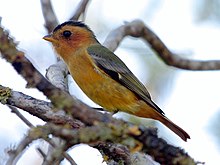| Black-capped piprites | |
|---|---|

| |
| Male at Campos do Jordão, São Paulo state, Brazil | |

| |
| Female at Campos do Jordão, São Paulo state, Brazil | |
| Scientific classification | |
| Domain: | Eukaryota |
| Kingdom: | Animalia |
| Phylum: | Chordata |
| Class: | Aves |
| Order: | Passeriformes |
| Family: | Tyrannidae |
| Genus: | Piprites |
| Species: | P. pileata
|
| Binomial name | |
| Piprites pileata (Temminck, 1822)
| |

| |
| Synonyms | |
|
Piprites pileatus | |
The black-capped piprites (Piprites pileata), also known as the black-capped manakin, bailarín castaño,[2] or piprites capirotado,[3] is a species of suboscine passerine. It has been placed in the genus Piprites, part of the Tyrannidae family. Previously, the species was included in the family Pipridae, but was reclassified following genetic studies.[4]
It is found in the Atlantic Forest, especially in regions where Araucaria angustifolia are found, in the highlands of southeastern Brazil and northeastern Argentina. Until the recent rediscovery in Argentina, the only confirmed record there was a specimen taken in 1959. It is considered as rare and its population is in decline; it is considered vulnerable by BirdLife International. It is known from a number of protected areas, including the Itatiaia National Park in Rio de Janeiro, and Campos do Jordão State Park in São Paulo.[1]
- ^ a b BirdLife International (2020). "Piprites pileata". IUCN Red List of Threatened Species. 2020: e.T22701205A153682590. doi:10.2305/IUCN.UK.2020-3.RLTS.T22701205A153682590.en. Retrieved 16 November 2021.
- ^ Bodrati, Alejandro; Maders, Claudio; Di Santo, Gastón; Cockle, Kristina; Ignacio Areta, Juan; Manuel Segovia, José (2009). "Distribución, hábitat, y historia natural del Bailarín Castaño Piprites pileata, una especie Críticamente Amenazada en Argentina" [Distribution, habitat, and natural history of the Bailarín Castaño Piprites pileata, a critically threatened species in Argentina]. Cotinga (in Spanish). 31.
- ^ Bernis, F; De Juana, E; Del Hoyo, J; Fernández-Cruz, M; Ferrer, X; Sáez-Royuela, R; Sargatal, J (2004). "Nombres en castellano de las aves del mundo recomendados por la Sociedad Española de Ornitología (Novena parte: Orden Passeriformes, Familias Cotingidae a Motacillidae)" (PDF). Ardeola. Handbook of the Birds of the World. 51 (2). Madrid: SEO/BirdLife: 491–499. ISSN 0570-7358. Retrieved 20 August 2024.
{{cite journal}}: CS1 maint: multiple names: authors list (link) - ^ Tello, Jose G.; Moyle, Robert G.; Marchese, Daniel J.; Cracraft, Joel (October 2009). "Phylogeny and phylogenetic classification of the tyrant flycatchers, cotingas, manakins, and their allies (Aves: Tyrannides)". Cladistics. 25 (5): 429–467. doi:10.1111/j.1096-0031.2009.00254.x. ISSN 0748-3007.
